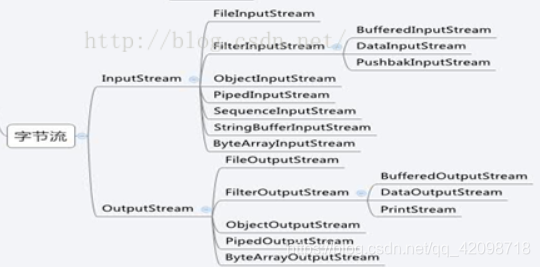本文主要借鉴以下博客和网站:
how2j.cn
深入理解java中的I/O
JAVA文件操作
JAVA描述和管理文件的类是java.io.File类,通过File生成的对象file,可以通过以下指令对文件进行操作:
- file.exists() – 判断文件是否存在
- file.isDirectory() – 判断文件是否为文件夹
- file.isFile() – 判断是否是普通文件(不是文件夹)
- file.length() – 获取文件的长度
- file.lastModified() – 获取文件最后修改的时间
- file.getAbsolutePath() – 获取文件的绝对路径
- file.list() – 返回当前文件夹的所有子文件的文件名(深度为1),返回类型为字符串数组
- file.listFiles() – 返回当前文件夹的所有子文件(深度为1),返回类型为文件数组
- file.getParent() – 返回当前文件的父文件夹的名字
- file.getParentFile() – 返回当前文件的父文件夹
- file.mkdir() – 创建文件夹(如果父类文件夹不存在,则创建无效)
- file.mkdirs() – 创建文件夹(如果父类文件夹不存在,则连同父文件夹一同创建)
- file.getParentFile().mkdirs() – 常用,创建一个文件前,常把父类目录都创好
- file.delete() – 删除文件
以下将展示几种流的使用方法(只展示读,写文件类似)
JAVA字节流
操作数据类型是字节,也就是JAVA数据类型中的byte,所有字节流的父类是InputStream和OutputStream(两个都是的抽象类)在这里插入代码片

直接上代码:
import java.io.*;
public class Main {
public static void main(String[] args) {
//文件中内容是 aAbB
File file = new File("src/blog/test.txt");
//对于文件操作,采用字节输入流子类FileInputStream
//建议采用在try括号内使用流的声明,即使在异常时也能关闭流,减少资源损耗
try(InputStream fi = new FileInputStream(file)){
byte[] bytes = new byte[(int) file.length()];
//将文件中的数据以字节流形式读入到bytes中
fi.read(bytes);
for(byte b : bytes) {
System.out.println(b);//打印ASCII码的十进制形式
}
}catch (FileNotFoundException fe) {
fe.printStackTrace();
} catch (IOException e) {
e.printStackTrace();
}
}
}
结果为(“aAbB”的ASCII码的十进制):
97
65
98
66
JAVA字符流
与字节流不同,字符流操作的数据对象的最小单元是字符,比较符合我们的日常读文本的习惯,所以在读文本时用的很多,具体的字符输入流和字符输出流为Reader和Writer,专门用于字符的形式读取和写入数据。
具体代码如下:
import java.io.*;
public class Main {
public static void main(String[] args) {
//文件中内容是 aAbB
// cCdD
File file = new File("src/blog/test.txt");
//对于文件操作,采用字符输入流FileReader
//建议采用在try括号内使用流的声明,即使在异常时也能关闭流,减少资源损耗
try(Reader fr = new FileReader(file)){
char[] chs = new char[(int) file.length()];
fr.read(chs);
for(char c : chs) {
System.out.print(c);
}
} catch (FileNotFoundException e) {
e.printStackTrace();
} catch (IOException e) {
e.printStackTrace();
}
}
}
运行结果如下(输出文本内容aAbBcCdD):
aAbB
cCdD
有时我们要对文本进行逐行处理,但以上的方法都是“一口将文件吃掉“,一次性读完所有的内容,这时我们需要一个新的流来帮我们一步步做,这时缓存流就登上了舞台。
JAVA缓存流
JAVA缓存流读取数据用的是BufferedReader,写入数据用的是BufferedWriter。这里用到了设计模式中的装饰者模式,在此不过多赘述,我们直接看缓存流是如何”装饰“字符流来实现逐行读取的。
代码如下:
import java.io.*;
public class Main {
public static void main(String[] args) {
//文件中内容是 aAbB
// cCdD
File file = new File("src/blog/test.txt");
//逐行读取,采用缓存流BufferedReader
//建议采用在try括号内使用流的声明,即使在异常时也能关闭流,减少资源损耗
try(
Reader fr = new FileReader(file);
BufferedReader br = new BufferedReader(fr);
)
{
String line = "";
while((line = br.readLine()) != null) {//读取一行
System.out.println(line.toUpperCase());//全部转化为大写
}
} catch (FileNotFoundException e) {
e.printStackTrace();
} catch (IOException e) {
e.printStackTrace();
}
}
}
输出处理后的结果:
AABB
CCDD
JAVA对象流
对象流指的是可以直接把一个对象以流的形式传输给其他的介质,但是,把一个对象序列化有一个前提是:这个对象的类,必须实现了Serializable接口。
注意,写入到文本时,对象以序列化后的二进制形式存放,用文本查看时会乱码
代码如下:
import java.io.*;
class Student implements Serializable{
//表示这个类当前的版本,如果有了变化,比如新设计了属性,就应该修改这个版本号
private static final long serialVersionUID = 1L;
String name;
int id;
public Student(String name, int id) {
this.name = name;
this.id = id;
}
@Override
public String toString() {
return "Student [name=" + name + ", id=" + id + "]";
}
}
public class Main {
public static void main(String[] args) {
File file = new File("src/blog/test.txt");
write(file);
read(file);
}
//写入对象
static void write(File file) {
try(
OutputStream out = new FileOutputStream(file);
ObjectOutputStream objout = new ObjectOutputStream(out);//对象输出流
)
{
Student[] students = new Student[2];
students[0]= new Student("xsy", 123456);
students[1] = new Student("theory", 654321);
objout.writeObject(students);//只能写一次
} catch (FileNotFoundException e) {
e.printStackTrace();
} catch (IOException e) {
e.printStackTrace();
}
}
//读取对象
static void read(File file) {
try(
InputStream in = new FileInputStream(file);
ObjectInputStream objin = new ObjectInputStream(in);//对象输入流
)
{
Student[] students = (Student[]) objin.readObject(); // 读取文件中的所有对象
for (Student s : students) {
System.out.println(s);
}
} catch (FileNotFoundException e) {
e.printStackTrace();
} catch (IOException e) {
e.printStackTrace();
} catch (ClassNotFoundException e) {
e.printStackTrace();
}
}
}
对象读取的运行结果为:
Student [name=xsy, id=123456]
Student [name=theory, id=654321]
JAVA数据流
数据流的目的在于对文本数据进行格式化读写,以下代码先写入一个整型int和字符串String,然后按顺序readInt和readUTF读取。
import java.io.DataInputStream;
import java.io.DataOutputStream;
import java.io.File;
import java.io.FileInputStream;
import java.io.FileOutputStream;
import java.io.IOException;
public class Main {
public static void main(String[] args) {
write();
read();
}
private static void read() {
File f =new File("src\blog\test.txt");
try (
FileInputStream fis = new FileInputStream(f);
DataInputStream dis =new DataInputStream(fis);
){
int i = dis.readInt();
String str = dis.readUTF();
System.out.println(i);
System.out.println(str);
} catch (IOException e) {
e.printStackTrace();
}
}
private static void write() {
File f =new File("src\blog\test.txt");
try (
FileOutputStream fos = new FileOutputStream(f);
DataOutputStream dos =new DataOutputStream(fos);
){
dos.writeInt(1);
dos.writeUTF("xsy");
} catch (IOException e) {
e.printStackTrace();
}
}
}
运行结果如下:
1
xsy